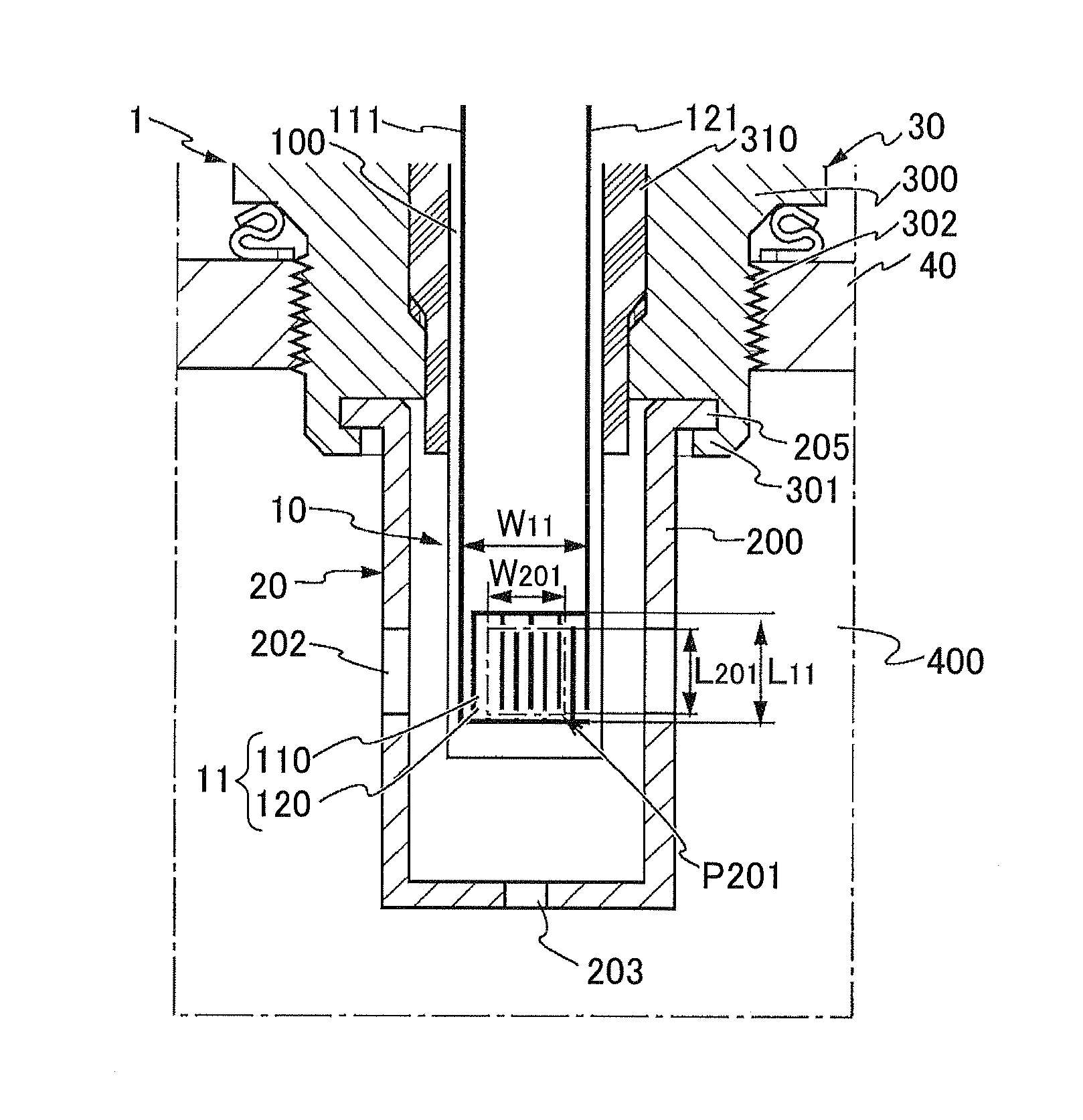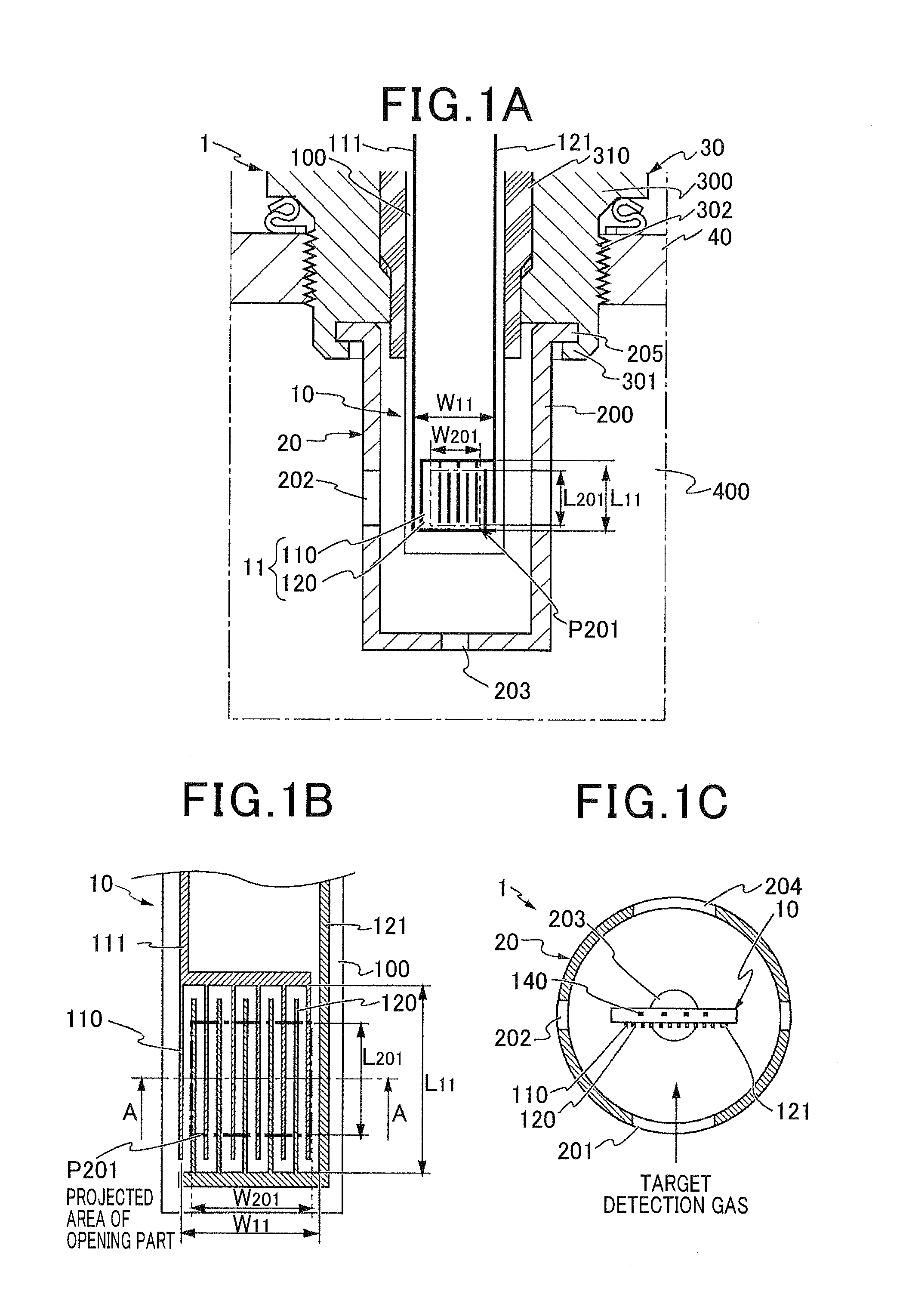Particulate matter detection sensor
a technology of particle matter and detection sensor, which is applied in the direction of measurement devices, instruments, scientific instruments, etc., can solve the problems of increased pressure loss of dpf, clogging of pores, and difficulty in executing the correct introduction of exhaust gas containing pm to the detection element without using an additional member, and achieves stable sensor and high accuracy
- Summary
- Abstract
- Description
- Claims
- Application Information
AI Technical Summary
Benefits of technology
Problems solved by technology
Method used
Image
Examples
first embodiment
[0051]A description will be given of a particulate matter detection sensor 1 (hereinafter, referred to as the “PM detection sensor 1”) according to a first exemplary embodiment of the present invention with reference to FIG. 1A to FIG. 8B.
[0052]FIG. 1A is a view showing a schematic cross section of a main part of the PM detection sensor 1 according to the first exemplary embodiment. FIG. 1B is a view showing a schematic cross section of a part of the PM detection sensor 1 according to the first exemplary embodiment. FIG. 1C is a view showing a cross section of the PM detection sensor 1 along the A-A line shown in FIG. 1B. FIG. 2 is a development view showing a perspective structure of a PM detection element 10 in the PM detection sensor 1 according to the first exemplary embodiment.
[0053]The PM detection sensor according to the first exemplary embodiment can be applied to exhaust gas purifying systems for internal combustion engines. The PM detection sensor detects electrical charac...
second exemplary embodiment
[0108]A description will now be given of a PM detection sensor 1b according to the second exemplary embodiment of the present invention with reference to FIG. 9.
[0109]FIG. 9 is a development view showing a perspective structure of a detection element 10b in the PM detection sensor 1b according to the second exemplary embodiment of the present invention.
[0110]Each of the PM detection sensor 1 according to the first exemplary embodiment and the PM detection sensor 1a as the modification has the detection part 11 (11a) composed of the detection electrodes 110 (110a) and 120 (120a) arranged in a comb structure.
[0111]On the other hand, the PM detection sensor 1b according to the second exemplary embodiment has the detection par 11b in which a pair of detection electrodes 110b and 120b is formed at a predetermined constant interval in parallel on the heat resistant substrate 100 along the longitudinal direction of the heat resistant substrate 100. In the PM detection sensor 1b, the detect...
third exemplary embodiment
[0121]A description will now be given of a PM detection sensor 1c according to the third exemplary embodiment of the present invention with reference to FIG. 11A, FIG. 11B, FIG. 12A1, FIG. 12A2, FIG. 12B1, FIG. 12B2, FIG. 12C1 and FIG. 12C2.
[0122]FIG. 11A is an expanded view showing the PM detection element 10c of the PM detection sensor 1c according to the third exemplary embodiment of the present invention. FIG. 11B is a view showing a cross section of the detection element 10c of the PM detection sensor 1c according to the third exemplary embodiment. FIG. 12A1, FIG. 12B1 and FIG. 12C1 are views showing a schematic cross section of the PM detection sensor 1c according to the third exemplary embodiment and the effect of the PM detection sensor 1c. FIG. 12A2, FIG. 12B2 and FIG. 12C2 are views showing a schematic side surface of the PM detection sensor 1c according to the third exemplary embodiment and the effect of the PM detection sensor 1c.
[0123]In the first and second embodiment...
PUM
 Login to View More
Login to View More Abstract
Description
Claims
Application Information
 Login to View More
Login to View More - R&D
- Intellectual Property
- Life Sciences
- Materials
- Tech Scout
- Unparalleled Data Quality
- Higher Quality Content
- 60% Fewer Hallucinations
Browse by: Latest US Patents, China's latest patents, Technical Efficacy Thesaurus, Application Domain, Technology Topic, Popular Technical Reports.
© 2025 PatSnap. All rights reserved.Legal|Privacy policy|Modern Slavery Act Transparency Statement|Sitemap|About US| Contact US: help@patsnap.com



